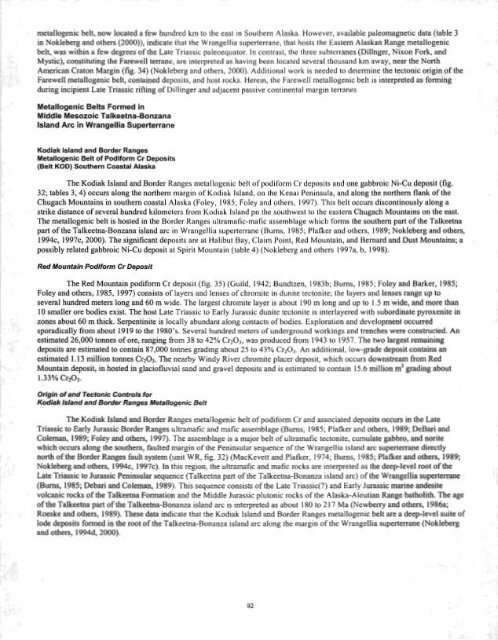Metallogenesis and Tectonics of the Russian Far East, Alaska, and ...
Metallogenesis and Tectonics of the Russian Far East, Alaska, and ...
Metallogenesis and Tectonics of the Russian Far East, Alaska, and ...
Create successful ePaper yourself
Turn your PDF publications into a flip-book with our unique Google optimized e-Paper software.
I metaUogeoic belt, now located a few hundred krn to <strong>the</strong> east in Sou<strong>the</strong>rn <strong>Alaska</strong>. However, available paleomapetic data (table 3<br />
inNokleberg <strong>and</strong> o<strong>the</strong>rs (2000)), lodicate that <strong>the</strong> Wrangellia superterrane, that hosts <strong>the</strong> <strong>East</strong>~rn <strong>Alaska</strong>n Range metallogenic<br />
bell was withia a few degrees <strong>of</strong> Be Late Triassic paleoequator. In contrast, <strong>the</strong> three subterranes (Dilhger, Nixon Fork, <strong>and</strong><br />
Mystio), colYfituling <strong>the</strong> <strong>Far</strong>ewell tmne, are interpreted as having been located several thous<strong>and</strong> km away, near he North<br />
American Craton Margin (fg 34) (Ndrleberg <strong>and</strong> o<strong>the</strong>rs, 2000). Additional work is needed to determine ths tecfonic origin <strong>of</strong> <strong>the</strong><br />
<strong>Far</strong>ewell metallogenic belt, ccmtained deposits, <strong>and</strong> host rocks. Herein, <strong>the</strong> <strong>Far</strong>ewell metallogenic belt is interpreted a6 wing during incipient Late Triassic rifting ~EDiIlinger <strong>and</strong> adjacent passive continental margin terranes<br />
i<br />
! M ~ ~ nQeb i Formed c in<br />
Middle Mesozoic Tm+k.etna-Bonzana<br />
lslond Arc in Wragellla Superterrane<br />
Kodak khad <strong>and</strong> Border Ranges<br />
Metallogedc Belt <strong>of</strong> Podifom Cr Deposits<br />
(blt KOD) Sohem Coastad Nwka<br />
The Kodittk lal<strong>and</strong> <strong>and</strong> Border Ranges metallogenic belt <strong>of</strong> podiform Cr deposits <strong>and</strong> om gabhie Ni-Cn depmt (fig<br />
32; tables 3,4) occurs along <strong>the</strong> nor<strong>the</strong>rn margin <strong>of</strong> Kodiak Isl<strong>and</strong>, on <strong>the</strong> Kenai Peninsula, <strong>and</strong> along <strong>the</strong> nor<strong>the</strong>rn flu& af UIU<br />
Chugacb Mountains in swrhem coastal <strong>Alaska</strong> (Foley, 1985; Foley <strong>and</strong> o<strong>the</strong>rs, 1997). This belt occurs discontimusly dong a<br />
strike dipkme <strong>of</strong>several hundred kihmeters from Kodiak Isl<strong>and</strong> pn <strong>the</strong> southwest to <strong>the</strong> eastern CBugach Motmtaim w Ihe east.<br />
The mttallogcuic beh is hosted in <strong>the</strong> Border Ranges ultramafic-mafic assemblage which forms <strong>the</strong> sou<strong>the</strong>rn part o€ <strong>the</strong> Talkeem<br />
part <strong>of</strong> <strong>the</strong> TalLeetna-Bonznna isl<strong>and</strong> arc in Wrangellia superterrane (Bums, 1985; Plafker <strong>and</strong> o<strong>the</strong>rs, 1989; Nokbcrg <strong>and</strong> o h ,<br />
1994c, t997c, 2000). The sipifitant deposits are at Halibut Bay, Claim Point, Red Mountain, <strong>and</strong> Bernard <strong>and</strong> h t Mountains; a<br />
at Spirit Mountain (table 4) (Nokleberg <strong>and</strong> o<strong>the</strong>rs 1997a, b, 1998).<br />
possibly dated gabbroic Ni-Cu w i t<br />
The Red Mountain podifonn Cr deposit (fig. 35) (Guild, 1942; Bundtzen, 1983b; Burns, 1985; Foley <strong>and</strong> Barker, 1985;<br />
Foley <strong>and</strong> o<strong>the</strong>rs. 1985, 1997) consists <strong>of</strong> layers <strong>and</strong> lenses <strong>of</strong> chromite in dunite tectonite; <strong>the</strong> layers <strong>and</strong> lensea w e up to<br />
several hundred meters long <strong>and</strong> 60 m wide. The largest chrornite layer is about 190 m long <strong>and</strong> up to 1.5 m wide, md mom &an<br />
10 smaller ore bodits exist. TRc host Late Triassic to Early Jurassic dunite tectonite is interlayered with subrhte pyweaite in<br />
mws about 60 m thidc. Sqentinite is locally abundant along contacts <strong>of</strong> bodies. Exploration <strong>and</strong> development occurred<br />
spora&aI.ly fiom but 1919 to <strong>the</strong> 1980's. Several hundred meters <strong>of</strong> underground workings <strong>and</strong> trenches were cmstmcted. An<br />
eatimatdd 26,000 tonne <strong>of</strong> ore, ranging fiom 38 to 42% Cr203, was produced from 1943 to 1957. The two Largest remaining<br />
deposits are esthatsd to contain 87,000 tonnes grading about 25 to 43% Cr20,. An additional, low-grade deposit contains im<br />
estimated 1.13 million tomes Cr201. The nearby Windy River chromite placer deposit, which occurs downs~eam from Red<br />
Mountah deposit, in hosted in glrtciohial s<strong>and</strong> <strong>and</strong> gravel deposits <strong>and</strong> is estimated to contain 15.6 millh m3 grading about<br />
133% Crp,.<br />
Origin <strong>of</strong> <strong>and</strong> Technic ConVols for<br />
thdhk lslsnd 8nd Border Ranger Metallogenic Belt<br />
The Kodiak lsl<strong>and</strong> <strong>and</strong> Border Ranges metallogenic belt <strong>of</strong> podiform Cr <strong>and</strong> associated deposits occlrn in She La&<br />
Triassic to Early Jurassic Border Ranges ultrarnafic <strong>and</strong> mafic assemblage (Bums, 1985; Plaker <strong>and</strong> a<strong>the</strong>rs, 1989; DeBari <strong>and</strong><br />
Cala~lan, 1989; Fdey <strong>and</strong> o h , 1997). The assemblage is a major belt <strong>of</strong> ultramafic tectonite, cumulate gabbm, d norite<br />
which ocuws almg bbe sou<strong>the</strong>rn, faulted margin <strong>of</strong> <strong>the</strong> Peninsular sequence <strong>of</strong> <strong>the</strong> Wrangellia isl<strong>and</strong> luc wpemrrme cbdy<br />
mrlh <strong>of</strong><strong>the</strong> Border R~agea fault system (unit WR, fig. 32) (MacKevett <strong>and</strong> Plaker, 1974; Burns, 1985; Plafker p ~d ohm, 1989;<br />
Nokleberg <strong>and</strong> ohen, 19Wc, 1997~). In this region, <strong>the</strong> ultrarnafic <strong>and</strong> mafic rocks are interpreted as <strong>the</strong> decpTevd mot dthc<br />
Late Trimk to Jurassic Peninsular sequence (Talkeetna part <strong>of</strong> <strong>the</strong> Talkeetna-Bonanza isl<strong>and</strong> arc) <strong>of</strong> t k WrangeHia supertarrane<br />
(Burns, 1985; hbui ard Coleman, 1989). This sequence consists <strong>of</strong> <strong>the</strong> Late Triassic(?) <strong>and</strong> Early Jurassic marine mdesito<br />
vokrulic rocks <strong>of</strong> tbe Talkaetna Formation <strong>and</strong> <strong>the</strong> Middle Jurassic plutonic rocks <strong>of</strong> <strong>the</strong> <strong>Alaska</strong>-Aleutian Raage balbolith. lk ep<br />
<strong>of</strong> <strong>the</strong> Talkeetna part <strong>of</strong>tbe Talkeeba-Bonanza isl<strong>and</strong> arc is interpreted as about 180 to 2 17 Ma (Newbemy <strong>and</strong> o<strong>the</strong>r& 1986q<br />
Rocske <strong>and</strong> o<strong>the</strong>rs, 1989). Tbtse data hdicate that <strong>the</strong> Kodiak Isl<strong>and</strong> <strong>and</strong> Border Ranges melallogenic belt an a deep-levd suih <strong>of</strong><br />
lode deposits formed in <strong>the</strong> root <strong>of</strong> <strong>the</strong> Talkeetna-Bonanza isl<strong>and</strong> arc along <strong>the</strong> margin <strong>of</strong> <strong>the</strong> Wrangellia amrrane (NoWcrg<br />
<strong>and</strong> olba 1994d, 2000).
















